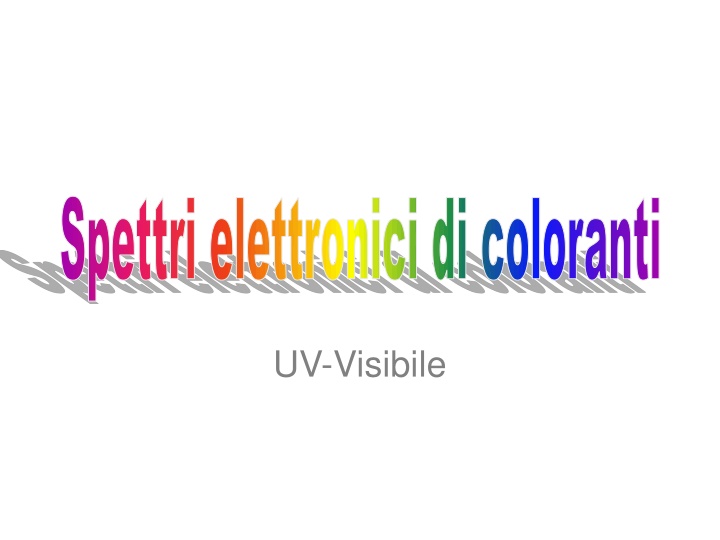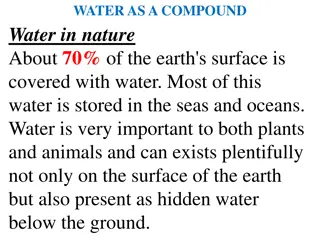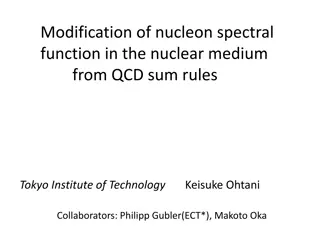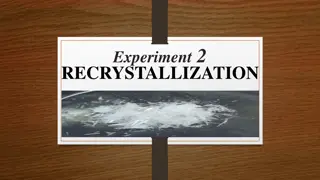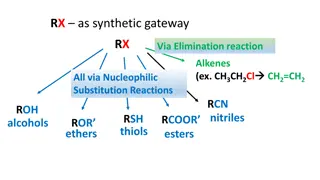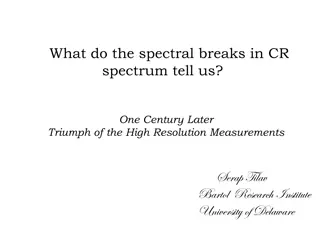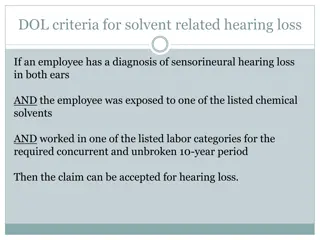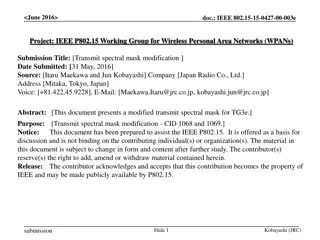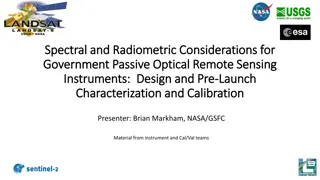Role of Solvent in Spectral Properties and Solvatochromism
Solvent plays a crucial role in physical and chemical processes, affecting kinetics, equilibria, and spectral properties such as UV-vis, IR, and NMR. Solvathochromism describes the change in spectral bands caused by solvent interactions. Factors like solvent polarity and hydrogen bonding influence dye behavior. Various empirical solvent scales and the Reichardt Polarity function (ET(30)) are used to quantify solute-solvent interactions. Solvatochromism in binary solvent mixtures can lead to preferential solvation and deviations from ideality.
Download Presentation

Please find below an Image/Link to download the presentation.
The content on the website is provided AS IS for your information and personal use only. It may not be sold, licensed, or shared on other websites without obtaining consent from the author.If you encounter any issues during the download, it is possible that the publisher has removed the file from their server.
You are allowed to download the files provided on this website for personal or commercial use, subject to the condition that they are used lawfully. All files are the property of their respective owners.
The content on the website is provided AS IS for your information and personal use only. It may not be sold, licensed, or shared on other websites without obtaining consent from the author.
E N D
Presentation Transcript
Spettri elettronici di coloranti UV-Visibile
Role of the solvent Solvent plays an important role in physical and chemical processes. Specific and non-specific interaction between the solvent and the solute molecules are responsible for the change observed in: Kinetics Chemical equilibria Spectral properties (UV-vis, IR, NMR) Solvathochromism It was observed, long ago, during comparison of the absorption spectra of a substance in the gas phase and in solution, that the solvent cause a change in the position, intensity and shape of the bands. Hantzsch termed the phenomenon solvathochromism [A. Hantzsch Ber. Dtch. Chem. Gess. 55, 953 (1922)] Empirical Parameters of the Polarity of Solvents C. Richardt Angew. Chem. Int. Ed. 4, 29-40 (1965)
Positive Solvathochromism The first excited state is better stabilized than the ground state, with increasing solvent polarity. A red shift is observed upon increasing the solvent polarity. E.g., - * Negative Solvathochromism With increasing solvent polarity, the ground state of he molecule is better stabilized by solvation than the excited state, (blue shift upon increasing the solvent polarity.) E.g., n- *, - *
Several factors influence the spectral behavior of a dissolved dye molecules, especially the solvent's polarity and its hydrogen-bond donor/acceptor abilities. Empirical solvent scales There is a great number of single parameter and multiparameter empirical solvent scales developed to describe and quantify the solute solvent interactions at a molecular level [A.R. Katritzky, D.C. Fara, H. Yang, K. T mm, T. Tamm, M. Karelson, Chem. Rev.104 (2004) 175 198.] e.g., the Kamlet -Taft equation is a well known multiparameter scale Kamlet, M. J., Abboud, J. L. M., Taft, R. W., J. Am. Chem. Soc., 99, 6027(1977)
Reichardt Polarity function ET(30) It is a single parameter scale based on the transition energy (ET) of the - * absorption of the betaine depicted below Since the standard dye was numbered 30 in [K. Dimroth, C. Reichardt, T. Siepman; F. Bohlman, Justus Liebigs Ann. Chem. 661, 1 (1963)] its molar transition energies were designate by ET(30).
Solvatochromism Solvatochromism in binary binary solvent solvent mixtures in mixtures The solute may induce a change in the composition of the solvents in the cybotactic region (the region around a solute molecule in which the solvent molecules are more ordered) compared to that in the bulk leading to preferential solvation. For an ideal solvation behavior, the value of the max of the solute in a binary mixture should follow a linear additive model, i.e. proportional to the molar fraction of any solvent. Deviation from ideality in the preferential solvation model: Preferential solvation Solvent-solvent interactyion close to the solute: complex solvent1-solvent2 in the cybotactic region
The dipole moment MeOHH2O hetero-dimer is higher 3.20 D than those of both water and MeOH. Although the difference in the dipole moments is small, the hetero-dimer exhibits a higher dipole moment that the pure solvent dimers. Furthermore by Cusin-Pagotto a.a. 2015-2016 Metilarancio in miscela acqua propanolo
Solvent composition from refractive index Refractive Indices, Densities and Excess Molar Volumes of Monoalcohols + Water J. V. Herraez, R. Belda J. Solution Chem. 2006, 35, 1315-1328
nD sper: experimental readings of refractive index changes Xsper so that diff*1000= 0 ricerca obiettivo
Metilarancio un diazocomposto che, grazie all estesa coniugazione, assorbe nel visibile e nel vicino UV con un elevato coefficiente di estinzione. =2.72 0.003 104 cm-1mol-1dm3
ACIDO - BASE Max 507 nm Max 462 nm
Dipendenza dello spettro di assorbimento del metilarancio dal solvente E dovuta alla sovrapposizione di due bande: una relativa alla forma non idratatata, a pi basse) e l altra alla forma idratata (legame idrogeno con l acqua), a pi alte
forma idratata: (467 nm)= 29700 M-1cm-1 forma non idratata: (418 nm)= 16500 M-1cm-1 in propanolo molto diminiuta la banda relativa alla specie legata idrogeno ed aumentata l altra Chem. Eur. J. 2000, 6, 3434-3441
Interazione con -ciclodestrina l interazione con ciclodestrina sposta la Max a valori pi bassi, sempre spostando i rapporti tra le due specie interazione host-guest
complesso di inclusione con ciclodestrina M. Kodaka J. Am. Chem. Soc. 1993, 115, 3702-3705
Coprecipitation with -CD and alkali halides to replace CN- in gold recovery Single-crystal superstructures of all eight adducts formed between -CD and MAuX4 (M = Na/K/Rb/Cs, X = Cl/Br). (a) Three views (front, side, and top) of adducts Na Br, K Br, Rb Br, and Cs Br. (b) Three views (front, side, and top) of adducts Na Cl, K Cl, Rb Cl, and Cs Cl. The [AuBr4] and [AuCl4] anions, as well as the alkali metal cations, are represented in space-filling format Hydrogen atoms are omitted for the sake of clarity. C, tan; O, red; Br, brown; Cl, green; Au, yellow; Na, K, Rb, Cs, purple. Published in: Zhichang Liu; Avik Samanta; Juying Lei; Junling Sun; Yuping Wang; J. Fraser Stoddart; J. Am. Chem. Soc. 2016, 138, 11643-11653. DOI: 10.1021/jacs.6b04986
Interazione con tensioattivi cationici CnTAB bromuro di alchiltrimetilammonio (n il numero di carboni della catena alchilica) C16TAB spesso abbreviato semplicemente con CTAB, in quanto la catena lineare a 16 atomi di carbonio chiamata cetile
Interazione con C12TAB a [C12TAB] molto bassa diminuisce l intensit della banda a 463 nm a [C12TAB] maggiori, ma sempre < della concentrazione critica micellare (cmc) compare una nuova banda a 380 nm (coppie ioniche, dimeri di metilarancio) a [C12TAB] > cmc l assorbimento si sposta nuovamente a lunghezze d onda maggiori dimeri H di azobenzene disposizione parallela forte shift ipsocromico
[metilarancio]= 2.510-5 M [C12TAB] in mM riportata sugli spettri pH 9.4 Buwalda, R. T. Langmuir1999, 15, 1083-1089
